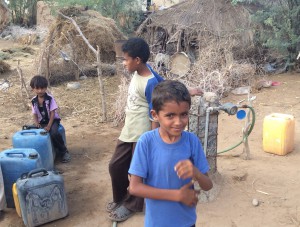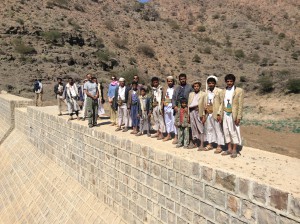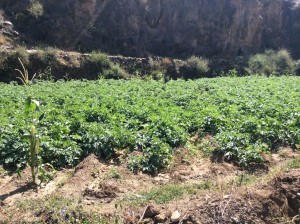The rains began in Sana’a this week. Once day it was dry; the next – almost 4pm on the dot, the heavens opened and the streets became flooded. Children rushed to play in the ankle-high puddles and adults hiked up their clothes to avoid them getting wet and sighed. Two weeks ago – 23rd March – was World Water Day.
Drinking water is one of the most precious resources on the planet and one that we need to manage it carefully –Yemenis more than most. We all know the story: Yemen is one of the most water-insecure and water-stressed countries globally and Sana’a could be the first capital city to run out of water altogether, possibly within the next decade. In Yemen around 30 per cent of people routinely use less than 15 litres of water per day per person. This is less than the minimum amount of water considered acceptable in response to a humanitarian crisis. Currently over 10 million Yemenis have no access to clean drinking water and over 12 million have no proper sanitation.
This increasing water scarcity can lead to conflict, especially if water resources are not well managed. How do we harness the water on Sana’a’s streets so it runs off in a drainage system into storage tanks that can then be filtered and used to provide for the city? When do we make a culture shift and grow crops that feed people not suppress their appetites: it takes 500 litres of water to produce a single bag of Qat; or a mere 290 litres of water per kilogramme for potatoes. How do we harness the salted water on Yemen’s 1,906 km of coastline and use it to make better lives? (Note: for that one, just ask Governor Shawki of Taiz, whose vision and innovation will eventually overcome Sana’a bureaucracy to deliver just that for Taiz people.)
The UK, through our Department for International Development is helping Yemen to tackle some of its problems. Our support to the Social Fund for Development (SFD) between 2011 and 2013 has provided over 9,000 households with access to improved drinking water sources and provided over 3,000 households with access to improved sanitation facilities.
Where possible this has been achieved using renewable water sources, including rainwater harvesting in storage tanks. I have seen at first-hand several examples of SFD water projects, and the way in which they have improved peoples’ lives. The water tank in Bani Alflayhei, Amran means that village women no longer need to walk to other villages to collect water, or buy expensive water delivered by truck. The dam in Bait Mazuor, Sana’a has enabled villagers to switch from subsistence farming to cash crops such as coffee, potatoes and other vegetables.
The UK is also improving access to clean water through its humanitarian relief programmes. Between 2013 and 2015 we will provide safe water to over 300,000 people in vulnerable communities and access to safe water to around 15,000 internally displaced people including supplying people displaced by the conflicts in Hajjah and Sa’ada with ceramic water filters and hygiene kits. It is important to take immediate action to provide individual communities with access to improved water and sanitation facilities. But we know that these effort are, well, a mere drop compared to need.
So it is equally important to consider the wider issue of water resource management in Yemen. The UK government funds a programme to help communities and local authorities work together to manage scarce water resources in a sustainable way. We fund an innovative project in Hodediah that takes the used water from a mosque, filters it naturally and provides clean water for the school next door.
These are important steps at a local level towards ensuring Yemen’s limited water resources are well managed but there is plenty more work to do to improve water resource management at a national level.
Of course in the end water management, like everything else, comes down to politics. The Taiz project would be delivering by now if it hadn’t been held hostage to politics. The vision for Yemen’s future needs to look at how the state – supported by the people – can deliver basic resources at affordable prices.




